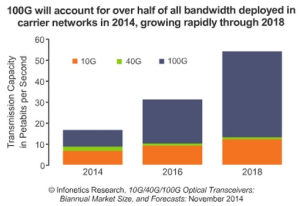-
The Migration from 40 Gigabit Ethernet to 100 Gigabit Ethernet
Although 40 Gigabit Ethernet is fast enough to satisfy most of today’s common data transmission, more and more people are looking forward to 100 Gigabit Ethernet because of the increasing demands of higher speed and greater bandwidth. Hence the transmission from 40 Gigabit Ethernet to 100 Gigabit Ethernet will be similar to that from 10 Gigabit Ethernet to 40 Gigabit Ethernet when 100 Gigabit Ethernet becomes commercially available.
The migration from 40 Gigabit Ethernet to 100 Gigabit Ethernet requires special equipment like transceivers, cables, switches and connectors, etc. Transceiver is one of the important equipment because fiber connectivity in higher-speed active equipment is being condensed and simplified with plug-and-play, hot-swap transceiver miniaturization, so here just introduces transceivers. According to the latest report from Infonetics, 100G accounts for over half of all bandwidth deployed in carrier networks in 2014, and will grow rapidly through 2018. From below diagram you can see, 100G is similar to 10G in 2014, but in 2016, it exceeds 10G and grows rapidly in 2018.

There are three kinds of transceivers. First, the C Form-Factor Pluggable (CFP) transceiver which contains 4 channels (each channel can support a data rate of 10 Gb/s) and brings a data rate up to 40 Gb/s. If the data rate should reach 100 Gb/s, CFP transceiver should feature 12 transmit and 12 receive 10-Gbps lanes. Second, CXP is usually called high-density CXP. CXP optical transceiver is hot pluggable. The CXP transceiver form factor provides 12 lanes in each direction for 100 Gigabit Ethernet. But it’s not wildly used for 40 Gigabit Ethernet. Third, the Quad Small-Form-Factor Pluggable (QSFP) is similar in size to the CXP and provides four transmit and four receive lanes to support 40 Gigabit Ethernet applications. If it’s used to serve 100 Gigabit Ethernet, the lane rates should increase to 25 Gbps.Compared to the components of 40 Gigabit Ethernet, components for 100 Gigabit Ethernet like 100G transceivers are still not so popular in the market due to the high costs. For example, the price of 40GBASE-SR4 QSFP+ transceiver may be about 500USD. But 100GBASE-LR4 CFP2 transceiver may be more than 6,000USD. So many manufacturers now put every effort to create a healthy 100G ecosystem, which will be beneficial for the entire community. Thus 100G solutions will soon meet customer’s power, performance, size and cost requirements. Once 100G components are commercial available, network operators will quickly capitalize 40G investments and adopt 100G transmission for their future deployments.
-
Commentaires
